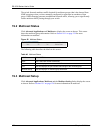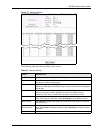
ES-2024 Series User’s Guide
129 Chapter 19 Multicast
MVR allows one single multicast VLAN to be shared among different subscriber VLANs on
the network. While isolated in different subscriber VLANs, connected devices can subscribe
to and unsubscribe from the multicast stream in the multicast VLAN. This improves
bandwidth utilization with reduced multicast traffic in the subscriber VLANs and simplifies
multicast group management.
You must enable IGMP snooping to use MVR. However, MVR only responds to IGMP join
and leave control messages from multicast groups that are configured under MVR. Join and
leave reports from other multicast groups are managed by IGMP snooping.
The following figure shows a network example. The subscriber VLAN (1, 2 and 3)
information is hidden from the streaming media server, S. In addition, the multicast VLAN
information is only visible to the switch and S.
Figure 59 MVR Network Example
19.5.1 Types of MVR Ports
In MVR, a source port is a port on the switch that can send and receive multicast traffic in a
multicast VLAN while a receiver port can only receive multicast data. Once configured, the
switch maintains a forwarding table that matches the multicast stream to the associated
multicast group.
19.5.2 MVR Modes
You can set your switch to operate in either dynamic or compatible mode.
In dynamic mode, the switch sends IGMP leave and join reports to the other multicast devices
(such as multicast routers or servers) in the multicast VLAN. This allows the multicast devices
to update the multicast forwarding table to forward or not forward multicast traffic to the
receiver ports.
In compatible mode, the switch does not send any IGMP reports. In this case, you must
manually configure the forwarding settings on the multicast devices in the multicast VLAN.
19.5.3 How MVR Works
The following figure shows a multicast television example where a subscriber device (such as
a computer) in VLAN 1 receives multicast traffic from the streaming media server, S, via the
switch. Multiple subscriber devices can connect through a port configured as the receiver on
the switch.


















